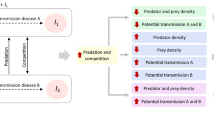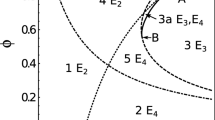Abstract
This article investigates the impact of predation on the coexistence and competitive exclusion of pathogen strains in the prey. Two types of predator are considered—a generalist and a specialist. For each type of predator, we assume that the predator can discriminate among susceptible and infected with each strain prey. The two strains will competitively exclude each other in the absence of predation with the strain with the larger reproduction number persisting. If a generalist predator preys discriminantly and the disease is fatal, then depending on the predation level, a switch in the dominant pathogen may occur. Thus, for some predation levels, the first strain may persist while for other predation levels the second strain may persist. Furthermore, a specialist predator preying discriminantly may mediate the coexistence of the two strains. Although in most cases increasing predation reduces the disease load in the prey, when predation leads to coexistence, it may also lead to increase in the disease load.
Similar content being viewed by others
References
Anderson, R.M., May, R.M., 1991. Infectious Diseases of Humans. Oxford University Press, Oxford.
Bremermann, H.J., Thieme, H.R., 1989. A competitive exclusion principle for pathogen virulence. J. Math. Biol. 27, 179–90.
Brauer, F., Castillo-Chavez, C., 2001. Mathematical Models in Population Biology and Epidemiology. Springer, New York.
Chattopadhyay, J., Arino, O., 1999. A predator-prey model with disease in the prey. Nonlinear Anal. Ser. B Real World Appl. 36, 747–66.
Collinge, S.K., Ray, C., 2006. Disease Ecology: Community Structure and Pathogen Dynamics. Oxford University Press, Oxford.
Delgado, M., Molina-Becerra, M., Suárez, A., 2006. Analysis of an age-structured predator-prey model with disease in prey. Nonlinear Anal. Real World Appl. 7 , 853–71.
Han, L., Ma, Z., Hethcote, H.W., 2001. Four predator prey models with infectious diseases. Math. Comput. Model. 34, 849–58.
Holt, R.D., 1977. Predation, apparent competition, and the structure of prey communities. Theor. Popul. Biol. 12, 197–29.
Holt, R.D., 1997. Community modules. In: Gange, A.C., Brown, V.K. (Eds.), Multitrophic Interactions in Terrestrial Ecosystems, pp. 333–49. Blackwell, Oxford.
Holt, R.D., Dobson, A.P., 2006. Extending the principles of community ecology to address the epidemiology of host-pathogen systems. In: Collinge, S.K., Ray, C. (Eds.), Disease Ecology: Community Structure and Pathogen Dynamics, pp. 6–7. Oxford University Press, Oxford.
Holt, R.D., Polis, G.A., 1997. A theoretical framework for intraguild predation. Am. Nat. 149, 745–64.
Holt, R.D., Roy, M., 2007. Predation can increase the prevalence of an infectious disease. Am. Nat. 169(5), 690–99.
Kermack, W.O., McKendrick, A.G., 1927. Contributions to the mathematical theory of epidemics. Proc. R. Soc. A 115, 700–21.
Lafferty, K.D., 2004. Fishing for lobsters imdirectly increases epidemics in sea urchins. Ecol. Appl. 14(5), 1566–573.
Lotka, A.J., 1925. Elements of Physical Biology. Williams and Wilkins, Baltimore.
May, R.M., 1988. Conservation and disease. Conserv. Biol. 2(1), 28–0.
Packer, C., Holt, R.D., Hudson, P.J., Lafferty, K.D., Dobson, A.P., 2003. Keeping herds healthy and alert: implications of predator control for infectious disease. Ecol. Lett. 6, 797–02.
Pech, R.P., Hood, G.M., 1998. Foxes, rabbits, alternative prey and rabbit calicivirus disease: consequences of a new biological control agent for an outbreaking species in Australia. J. Appl. Ecol. 35, 434–53.
Pimm, S.L., 2002. Food Webs. The University of Chicago Press, Chicago.
Saenz, R.A., Hethcote, H.W., 2006. Competing species models with an infection disease. Math. Biosci. Eng. 3, 219–35.
Scott, M.E., 1988. The impact of infection and disease on animal populations: Implications for conservation biology. Conserv. Biol. 2(1), 40–6.
Smith, D.J., 2006. Predictability and preparedness in influenza control. Science 312, 392–94.
Xiao, Y., Chen, L., 2001a. Analysis of a three species eco-epidemiological model. J. Math. Anal. Appl. 258, 733–54.
Xiao, Y., Chen, L., 2001b. Modeling and analysis of a predator-prey model with disease in the prey. Math. Biosci. 171, 59–2.
Xiao, Y., Chen, L., 2002. A ratio-dependent predator-prey model with disease in the prey. Appl. Math. Comput. 131, 397–14.
Author information
Authors and Affiliations
Corresponding author
Rights and permissions
About this article
Cite this article
Martcheva, M. Evolutionary Consequences of Predation for Pathogens in Prey. Bull. Math. Biol. 71, 819–844 (2009). https://doi.org/10.1007/s11538-008-9383-5
Received:
Accepted:
Published:
Issue Date:
DOI: https://doi.org/10.1007/s11538-008-9383-5




